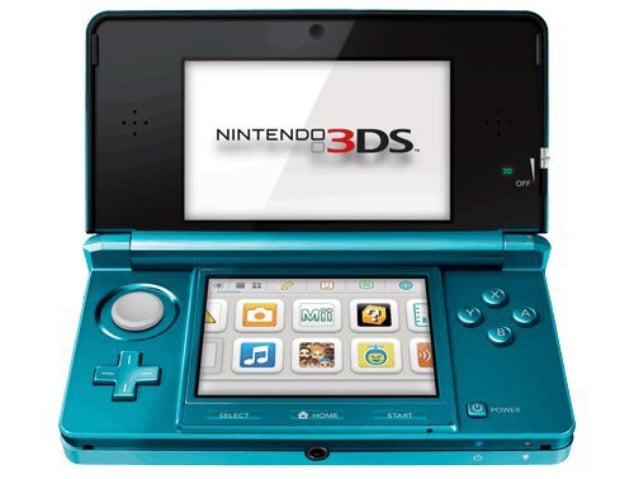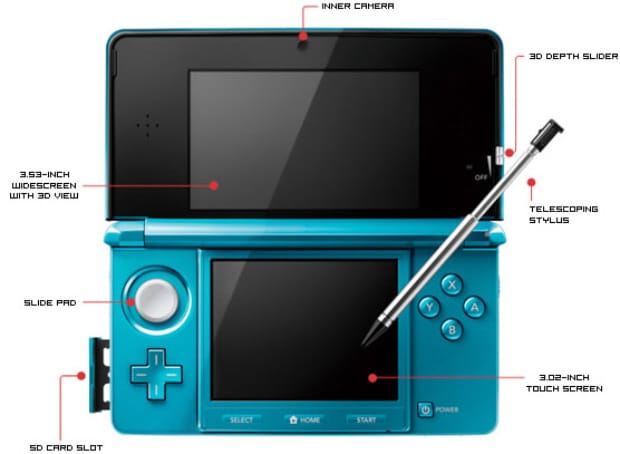
3D games, photos, entertainment and more, all with no glasses required. That’s the new Nintendo 3DS!
The release date for 3DS is March 25th in Europe, March 27th in North America and March 31st in Australia. Japan got the system on February 26th. The 3DS is the successor to the DS(i) line of systems and is a whole new portable game system that features all-new graphics capability and all-new features.
The 3DS will cost: US$249.99, £/€ – Set by individual retailers, A$349.9 at launch and comes in two colors: Blue (Aqua Blue) and Black (Cosmo Black).
Let’s start you out with an official video from Nintendo that shows the new features of the 3DS and improvements over the DSi. Watch it here:
Launch Games
There are 16 launch games for the 3DS. They include: PilotWings Resort, Steel Diver and Nintendogs + Cats from Nintendo, Super Street Fighter IV 3D Edition from Capcom, The Sims 3 and Madden NFL Football from EA Sports, Lego Star Wars III: The Clone Wars from LucasArts, Ridge Racer 3D from Namco, Super Monkey Ball 3D from Sega, Bust-A-Move Universe from Square Enix, Samurai Warriors: Chronicles from Tecmo Koei, Pro Evolution Soccer 2011 3D from Konami, and Rayman 3D, Ghost Recon: Shadow Wars, Combat of Giants: Dinosaurs 3D and Asphalt 3D from Ubisoft. Additionally, the 3DS comes with quite a few AR Games (with a set of included AR Games cards), Face Raiders (a game that uses the 3DS cameras), and Mii Maker pre-installed into each system.
This video gives you a look at each of the 3DS launch games and the AR Games.
New Features of the 3DS
The 3DS includes three 640×480 0.3 megapixels cameras (one inner and two outer), similar to the DSi. The two outer cameras have the extended ability to take stereoscopic 3D photos, which you can then share with friends by sending it to their 3DS via wi-fi. The 3DS is one of the first devices, and arguably the first “mass market” device to allow for stereoscopic glasses-free 3D photo-taking and sharing.
Built-in to the 3DS is a accelerometer, and a gyroscope, giving the system the ability to interact with what’s on the screen by tilting the system, just like with a iPhone. The 3DS features the same control layout as previous DS systems with one new exception, the new analog “Circle Pad” will finally make playing 3D games without using the stylus feel natural.
You can see the accelerometer and a gyroscope being used to allow Link to look around in Zelda: Ocarina of Time 3D by physically moving the system while in first-person view mode as shown in this video.
The system has a touch-screen on the bottom (the top-screen is NOT a touch-screen, just a “autostereoscope” one) with R (Right) and L (Left) shoulder buttons and A, B, X and Y face buttons, D (Directional)-Pad as well as Select, Start and “Home”. As well as a Volume Slider and Headphone Jack. The Home button will allow you to launch the system “Channels” menu without exiting out of the game you are playing. There is also a “3D Depth Slider” button that allows you to turn the stereoscopic effect of the top-screen off completely, or lower the effect of the 3D. A bigger and better telescoping stylus (Extendable up to 100 mm (3.9 in) long) comes with the system as well.
There is also a built-in microphone (more games will have voice chat) and a Wireless Communications switch (allowing you to turn off all wireless communication) and an IR (Infrared, like on a TV Remote) Port, allowing you to send data directly to another 3DS system wireless and more quickly than wi-fi. Great for Pokemon battles/trades with friends in the same room as you. The system also has an SD Card Slot, like the DSi before it. Which you can store info on or view info on the Card.
The 3DS features an easier Friend Code system for online play with one Friend Code required per console per friends, instead of per game and the 3DS has an E-Shop where you can download DSiWare or Virtual Console games that include past-systems such as the Game Boy, Game Boy Color, Sega Game Gear or TurboGrafx-16. Unlike the Wii and DSi, the eShop uses real money for transactions in place of a “Nintendo Points” system. A web-browser will also allow you to access the Internet just as with the DSi. The 3DS is also fully backwards compatible with all previous DS games. That means you can play any previous DS release on the new system. Additionally, all DSiWare that you’ve purchased on your old DSi can be moved to the 3DS via the eShop Channel, so all that money won’t have gone to waste! There will also be a “3D Classics” line of remastered retro games that will be optimized with stereoscopic 3D graphics, even for 2D games!
The 3DS includes an Activity Log, which will track how long you’ve played each game and various stats on how you’ve used the system. It will even keep track of your physical activity, counting every step you’ve taken while carrying the 3DS; turning it into an automatic fitness machine. Additionally, certain games can make use of this interesting feature (most likely inspired by the original Nintendogs, that let you walk your dog) and you can even earn “Play Coins”. You get Play Coins for walking with your 3DS, and you can use these in compatible games or applications to unlock special content and other benefits (depending on the game or application naturally). Note that Play Coins are not money and can’t be used to purchase items on the eShop.
SpotPass and StreetPass are two interesting wi-fi features of the 3DS. Like the DSi before it, the 3DS can connect to the Internet via a wireless Internet connection. Once connected you can download new Apps or Games at the eShop, and play your games online with others in supported titles. Spotpass is the “always-online” feature of the 3DS which allows it to download updates or content in the background as long as you are connected to the Internet.
StreetPass is similar, but allows you to share info with people you pass on the “street” who also have their 3DS StreetPass feature enabled. Sharing content this way is done completely in the background with no required input from the user, even if the system is dormant. You will also be able to share Miis with people you have passed, and see what games they have played and what mutual titles you share. As well add them to your friends list. Certain titles can take advantage of these StreetPass features as well. For example in Super Street Fighter IV for 3DS, you can collect Trophies that will battle other people’s Trophies whom you’ve passed in StreetPass mode. When you turn your system on again, you can see whose Trophy won the battle. Content exchanged between games with StreetPass can include multiple titles, does not have to be activated per title (just activated via the “StreetPass” Channel on your 3DS Main Menu), and won’t be effected by what games you are currently playing or what game is currently in the slot for play. You will be alerted to all the changes and data that has been shared (or downloaded via SpotPass) when you turn your system on or bring it out of Sleep Mode by opening it up. Additionally, Nintendo has partnered with AT&T to provide free wi-fi Internet access for 3DS users at hundreds of locations across the United States, with similar partnerships announced or in the works in other regions as well.
There are many other features of the 3DS, here are some of them:
Augmented Reality
The 3DS allows players to use the real-world to interact with videogame creatures by pointing the outside cameras at special black cards that ship with the system. These cards make it appear as if a creature or object is interacting with the real world. These games are dubbed “AR Games”. And some pre-built AR Games will ship with the 3DS as well as a set of AR cards. You can buy or obtain new AR Cards that will do different things. These games are accessible via the “AR Games” Channel on the system menu.
Here is a video showing the AR Games in action.
Movies and Video
A Video Channel on the 3DS called “3D Video” will allow players to view stereoscopic 3D trailers for Hollywood movies and videogames. Additional video content is in the works and could possibly include big-name feature films from Hollywood studios. Studios that Nintendo is currently penning deals with include Warner Bros, Disney, and DreamWorks. Additional video content will include short films and comedy shorts, music videos, informational videos, possible sports and news clips and unique video content like a series of animated Shaun the Sheep shorts from Aardman Studios that are exclusive to the 3DS Video Channel.
Netflix on 3DS
In addition to the above, Netflix will be coming soon to 3DS and will allow 3DS users to instantly stream hundreds of movies and TV shows directly to their handheld as long as they already have a Netflix account! No word on when or if stereoscopic 3D movies will be added to Netflix to take advantage of the system’s unique 3D capabilities, but you’d imagine that 3D movies will eventually be added to Netflix anyway, as 3D TVs get more popular. So it’s not a stretch to say that stereoscopic 3D movies via Netflix may soon be available on 3DS.
3DS Messaging Service
Replacing Pictochat from the previous DSi systems is a new messaging service that is more similar to that of the Wii. You can send notes to your friends’ 3DS systems and you will be alerted to a new message by the Notification LED when you recieve one. In order to send messages to people you will have to exchange your 3DS Friend Code with them.
Charge Cradle
The 3DS ships with a cradle that you can set the system in to charge it while at home. This cradle additionally will offer faster download and upload speeds for when SpotPass is in use via a local wi-fi connection.
Mii Maker
You will be able to create more detailed Miis, similar to the Miis seen on the Wii, with the Mii Maker. These caricatures are simple humanoids that resemble you, which you can customize by choosing the facial details of your Mii. This Mii will serve as your Avatar when playing online. You can import Miis from your Wii, but not from your 3DS to your Wii (although that may change in the future). Additionally, you can even take a photo of yourself or someone else and have the 3DS generate a Mii based on the facial details seen in the photo! Miis can be shared with your friends via wi-fi and you can see the Miis of those you pass in StreetPass mode or when playing online. Like on the Wii, a “Mii Plaza” will house all of the Miis you have come into contact with or downloaded. Miis can even be captured and generated by using special QR Codes using the 3DS cameras!
Music and Photos
The 3DS like the DSi before it can play music that is stored on an SD Card that is inserted into the SD Card slot. You can also view photos stored on an SD card as well as video (presumably). The 3DS will include a music player via the “3DS Sound” Channel, that will also allow you to play around with music media or record short audio clips using the built-in microphone. No word on what filetypes the 3DS can read.
Region Locked
The Nintendo 3DS is region-locked, meaning that you cannot play games from other regions that are different than your own (if you live in North America, you cannot play games from Japan. If you live in Europe, you can not play games from North America or Canada, et al).
Detailed 3DS Statistics
Screen Size
Upper Screen: Widescreen 3D LCD (800×240 or 400×240 per eye)
Upper Screen Size: 3.52″ diagonally
Lower Screen: LCD Touchscreen (320×240)
Lower Screen Size: 3.02″ diagonally
GPU Pica200. Comparable to the Nintendo Wii in graphical power.
Processor: Nintendo ARM
Graphics: PICA200 by Digital Media Professionals
Storage: 2 GB NAND flash memory
RAM: TBA
Dimensions: 134 mm (5.3 in) wide × 74 mm (2.9 in) deep × 21 mm (0.83 in) high
Display: Autosteroscopic 3.53 in (90 mm), 800 × 240 px (effectively 400 × 240 WQVGA per eye), 3.02 in (77 mm), 320 × 240 QVGA, 24-bit color
Colors: Approximately 16.7 million
Weight 230 grams (8.1 oz)
Cameras: 0.3 Megapixels – (2 on the outer case and 1 inside)
Wireless Function: 2.4GHz (100 feet recommended range)
Sound: Stereo speakers to the right and left of the top screen
Stylus: Telescoping stylus (3.95 inches extended)
Power: AC adapter and lithium ion battery
Charge Time: Approximately 3.5 hours
Battery Life: Approximately 3-5 hours for 3DS games (depending on screen brightness, Wi-Fi, sound volume, and 3D effect) and 5-8 hours for DS games.
Now let’s score the handheld to see what the overall fun-factor is…
OVERALL FUN FACTOR – 10
Reason: It’s super duper fun… in 3D! Nintendo have made the best handheld ever created with unlimited potential. Did I mention it’s freaking glasses-free 3D!? It’s awesome!!

